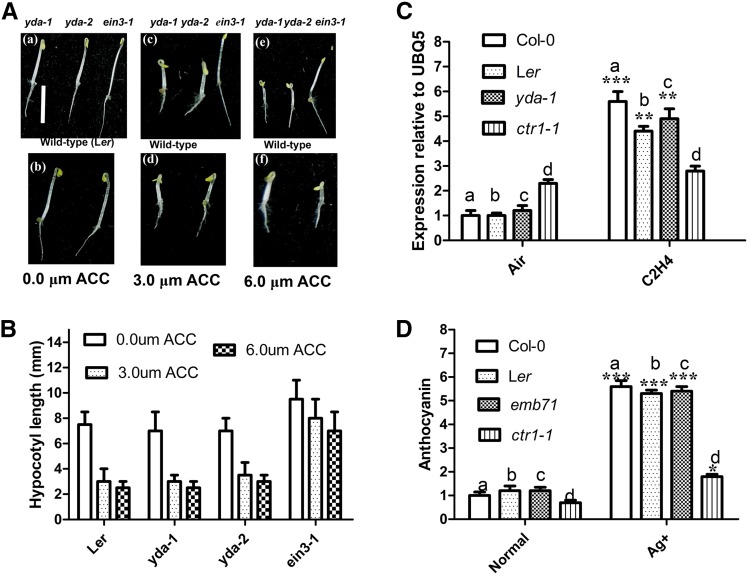Figure 1.
EMB71/YDA is not involved in ethylene signaling. (A) Representative 4-day-old yda-1 (a), yda-2 (a), ein3-1 (a), and Ler (b) seedlings grown on solid MS medium without ACC (1-aminocyclopropane-1-carboxylic acid); 4-day-old yda-1 (c), yda-2 (c), ein3-1 (c), and Ler (d) seedlings grown on solid MS medium with 3.0 m ACC; and 4-day-old yda-1 (e), yda-2 (e), ein3-1 (e), and Ler (f) seedlings grown on solid MS medium with 6.0 m ACC. Bar, 5.0 mm for a–f. (B) Bar graph exhibiting the difference in hypocotyl length between Ler, yda-1, yda-2, and ein3-1 seedlings grown on solid MS medium with 0.0 m ACC, 3.0 mACC, and 6.0 mACC, respectively. Error bars represent SD (n = 16). Experiments were repeated three times with similar results. (C) Bar graph exhibiting the difference of expression of ERF1 between 8-day-old wild-type (Col-0), Ler, yda-1, and ctr1-1 light-grown seedlings with or without ethylene (25 ppm) for 5 hr. Data were from quantitative RT-PCR. Error bars indicate SD (n = 3; ** P < 0.01, *** P < 0.001). Value of wild-type seedlings without ethylene is set at 1.0. Quantifications were normalized to the expression of UBQ5. (D) Bar graph exhibiting the difference in anthocyanin accumulation between 10-day-old wild-type (Col-0), Ler, emb71, and ctr1-1 seedlings grown under white light. Wild-type value is set as 1.0. Error bars represent SD (n = 14; * P < 0.05, *** P < 0.001). Experiments were repeated two times with similar results.

